High Thermal Dissipation of Al Heat Sink When Inserting Ceramic Powders by Ultrasonic Mechanical Coating and Armoring
Abstract
:1. Introduction
2. Model of Heat Loss
2.1. Thermal Radiation and Convection
2.2. Heat Equation of Conduction
3. Experimental Materials and Procedures
4. Results and Discussion
4.1. Basic UMCA Morphology
4.2. Effects of Surface Roughness on the Thermal Radiation
4.3. Effects of Powder Size on the Thermal Radiation
4.4. Effects of UMCA Cycles on the Thermal Radiation
4.5. Effects of Heat Input Power on the Thermal Radiation
4.6. Comparison of Thermal Radiation by Difference Powder Combinations
4.7. Application to Real Heat Sink Fins
4.8. Comparison of the Analytic Model and Experimental Observations
4.9. Closing Remarks
5. Conclusions
- (1)
- The coated ceramic powder size imposes an effect on the resulting thermal radiation efficiency. The large ~15 μm powders perform better than the small ~0.5 μm powders.
- (2)
- With an increasing number of UMCA cycles, the powders can be spread over a higher surface area and can be inserted into deeper locations. Both effects result in a higher thermal radiation efficiency.
- (3)
- For the same coating, the thermal radiation efficiency is higher under a higher input heat power, namely, a higher thermal radiation efficiency occurs at higher temperatures.
- (4)
- In comparison with the three powders in use, graphite (with a total emissivity of 0.98) performs the best, followed by Al2O3 (0.94) and SiO2 (0.90).
- (5)
- A mixture of different powders, such as SiO2+Al2O3+Graphite, results in an even better thermal radiation efficiency. For the 1050 Al plate sample with only one surface side coated by UMCA, the temperature drop with respect to uncoated Al was 8.2 °C.
- (6)
- For commercial heat sink samples with multiple fins, UMCA can be conducted on both sides of the fins. The resulting temperature drop with respect to uncoated Al was as high as 11.1 °C.
- (7)
- An analytical model was established, and the theoretically predicted temperature drop with respect to Al is a prescreening evaluation for heat sink samples of different shapes, different dimensions, coatings of different ceramic powders, and different amounts of coating. Overall, the agreements between the model predictions and experimental measurements are satisfactory.
Acknowledgments
Author Contributions
Conflicts of Interest
References
- He, X.; Li, Y.; Wang, L.; Sun, Y.; Zhang, S. High emissivity coatings for high temperature application: Progress and prospect. Thin Solid Films 2009, 517, 5120–5129. [Google Scholar] [CrossRef]
- Stefanidis, G.; van Geem, K.; Heynderickx, G.; Marin, G. Evaluation of high-emissivity coatings in steam cracking furnaces using a non-grey gas radiation model. Chem. Eng. J. 2008, 137, 411–421. [Google Scholar] [CrossRef]
- Heynderickx, G.J.; Nozawa, M. High-emissivity coatings on reactor tubes and furnace walls in steam cracking furnaces. Chem. Eng. Sci. 2004, 59, 5657–5662. [Google Scholar] [CrossRef]
- Narendran, N.; Gu, Y. Life of LED-based white light sources. J. Disp. Technol. 2005, 1, 167. [Google Scholar] [CrossRef]
- Arik, M.; Petroski, J.; Weaver, S. Thermal challenges in the future generation solid state lighting applications: Light emitting diodes. In Proceedings of the Eighth Intersociety Conference on Thermal and Thermomechanical Phenomena in Electronic Systems, San Diego, CA, USA, 30 May–1 June 2002; pp. 113–120. [Google Scholar]
- Wei, J.; Yi, Z.; Wang, L.; Liu, L.; Wu, H.; Wang, G.; Zhang, B. White LED light emission as a function of current and junction temperature. In Proceedings of the 10th China International Forum on Solid State Lighting (ChinaSSL), Beijing, China, 10–12 November 2013; pp. 166–169. [Google Scholar]
- Liu, J.; Tam, W.S.; Wong, H.; Filip, V. Temperature-dependent light-emitting characteristics of InGaN/GaN diodes. Microelectron. Reliab. 2009, 49, 38–41. [Google Scholar] [CrossRef]
- Kim, D.S.; Han, B. Effect of junction temperature on heat dissipation of high power light emitting diodes. J. Appl. Phys. 2016, 119, 125104. [Google Scholar] [CrossRef]
- Kim, M.H.; Schubert, M.F.; Dai, Q.; Kim, J.K.; Schubert, E.F.; Piprek, J.; Park, Y. Origin of efficiency droop in GaN-based light-emitting diodes. Appl. Phys. Lett. 2007, 91, 183507. [Google Scholar] [CrossRef]
- Lumileds, P. Technology White Paper: Understanding Power LED Lifetime Analysis. Available online: http://www.climateactionprogramme.org/images/uploads/documents/Philips_Understanding-Power-LED-Lifetime-Analysis.pdf (accessed on 7 May 2007).
- Hong, E.; Narendran, N. A method for projecting useful life of LED lighting systems. In Optical Science and Technology, Proceedings of the SPIE’s 48th Annual Meeting, San Diego, CA, USA, 5–7 August 2003; International Society for Optics and Photonics: Bellingham, WA, USA, 2004; pp. 93–99. [Google Scholar]
- Cheng, H.H.; Huang, D.S.; Lin, M.T. Heat dissipation design and analysis of high power LED array using the finite element method. Microelectron. Reliab. 2012, 52, 905–911. [Google Scholar] [CrossRef]
- Jang, D.; Yu, S.H.; Lee, K.S. Multidisciplinary optimization of a pin-fin radial heat sink for LED lighting applications. Int. J. Heat Mass Transf. 2012, 55, 515–521. [Google Scholar] [CrossRef]
- Lu, X.Y.; Hua, T.C.; Wang, Y.P. Thermal analysis of high power LED package with heat pipe heat sink. Microelectron. J. 2011, 42, 1257–1262. [Google Scholar] [CrossRef]
- Choi, J.; Jeong, M.; Yoo, J.; Seo, M. A new CPU cooler design based on an active cooling heatsink combined with heat pipes. Appl. Therm. Eng. 2012, 44, 50–56. [Google Scholar] [CrossRef]
- Huang, J.; Fan, C.; Song, G.; Li, Y.; He, X.; Zhang, X.; Sun, Y.; Du, S.; Zhao, Y. Enhanced infrared emissivity of CeO2 coatings by La doping. Appl. Surf. Sci. 2013, 280, 605–609. [Google Scholar] [CrossRef]
- Yi, J.; He, X.; Sun, Y.; Li, Y. Electron beam-physical vapor deposition of SiC/SiO2 high emissivity thin film. Appl. Surf. Sci. 2007, 253, 4361–4366. [Google Scholar] [CrossRef]
- Wang, F.; Cheng, L.; Zhang, Q.; Zhang, L. Effect of surface morphology and densification on the infrared emissivity of C/SiC composites. Appl. Surf. Sci. 2014, 313, 670–676. [Google Scholar] [CrossRef]
- Zhang, J.; Fan, X.A.; Lu, L.; Hu, X.; Li, G. Ferrites based infrared radiation coatings with high emissivity and high thermal shock resistance and their application on energy-saving kettle. Appl. Surf. Sci. 2015, 344, 223–229. [Google Scholar] [CrossRef]
- Tang, H.; Xin, T.; Sun, Q.; Yi, C.; Jiang, Z.; Wang, F. Influence of FeSO4 concentration on thermal emissivity of coatings formed on titanium alloy by micro-arc oxidation. Appl. Surf. Sci. 2011, 257, 10839–10844. [Google Scholar] [CrossRef]
- Beozzo, C.C.; Alves-Rosa, M.A.; Pulcinelli, S.H.; Santilli, C.V. Liquid foam templates associated with the sol-gel process for production of zirconia ceramic foams. Materials 2013, 6, 1967–1979. [Google Scholar] [CrossRef]
- Bull, S.J. Failure modes in scratch adhesion testing. Surf. Coat. Technol. 1991, 50, 25–32. [Google Scholar] [CrossRef]
- Sánchez, J.M.; El-Mansy, S.; Sun, B.; Scherban, T.; Fang, N.; Pantuso, D.; Ford, W.; Elizalde, M.R.; Martı́nez-Esnaola, J.M.; Martı́n-Meizoso, A.; et al. Cross-sectional nanoindentation: A new technique for thin film interfacial adhesion characterization. Acta Mater. 1999, 47, 4405–4413. [Google Scholar] [CrossRef]
- Komarov, S.V.; Son, S.H.; Hayashi, N.; Kaloshkin, S.D.; Abramov, O.V.; Kasai, E. Development of a novel method for mechanical plating using ultrasonic vibrations. Surf. Coat. Technol. 2007, 201, 6999–7006. [Google Scholar] [CrossRef]
- Romankov, S.; Komarov, S.; Vdovichenko, E.; Hayasaka, Y.; Hayashi, N.; Kaloshkin, S.; Kasai, E. Fabrication of TiN coatings using mechanical milling techniques. Int. J. Refract. Met. Hard Mater. 2009, 27, 492–497. [Google Scholar] [CrossRef]
- Tao, N.; Wang, Z.; Tong, W.; Sui, M.; Lu, J.; Lu, K. An investigation of surface nanocrystallization mechanism in Fe induced by surface mechanical attrition treatment. Acta Mater. 2002, 50, 4603–4616. [Google Scholar] [CrossRef]
- Wang, Z.; Lu, J.; Lu, K. Chromizing behaviors of a low carbon steel processed by means of surface mechanical attrition treatment. Acta Mater. 2005, 53, 2081–2089. [Google Scholar] [CrossRef]
- Chou, H.; Huang, J.; Chang, L. Mechanical properties of ZrCuTi thin film metallic glass with high content of immiscible tantalum. Surf. Coat. Technol. 2010, 205, 587–590. [Google Scholar] [CrossRef]
- Halliday, D.; Walker, J.; Resnick, R. Fundamentals of Physics, Chapters 33–37; John Wiley & Sons: Somerset, NJ, USA, 2010. [Google Scholar]
- Johnson, R.W. Handbook of Fluid Dynamics; CRC Press: Boca Raton, FL, USA, 2016. [Google Scholar]
- Culham, J.R.; Yovanovich, M.M.; Lee, S. Thermally modeling isothermal cuboids and rectangular sinks cooled by natural convection. IEEE Trans. Compon. Packag. Manuf. Technol. 1995, 18, 559–566. [Google Scholar] [CrossRef]
- Yovanovich, M.M.; Jafarpur, K. Models of Laminar natural convection from vertical and horizontal isothermal cuboids for all Prandtl numbers and all Rayleigh numbers below 1011. In Proceedings of the 114th ASME Winter Annual Meeting, New Orleans, LA, USA, 28 November–3 December 1993. [Google Scholar]
- Radziemska, E.; Lewandowski, W.M. Experimental verification of natural convective heat transfer phenomenon from isothermal cuboids. Exp. Therm. Fluid Sci. 2008, 32, 1034–1038. [Google Scholar] [CrossRef]
- Radziemska, E.; Lewandowski, W.M. Natural convective heat transfer from isothermal cuboids. Int. J. Heat Mass Transf. 2003, 46, 2169–2178. [Google Scholar] [CrossRef]
- Cannon, J.R. The One-Dimensional Heat Equation; Cambridge University Press: Cambridge, UK, 1984. [Google Scholar]
- Europe Technologies Group. STRESSONIC® Principle. Available online: http://www.sonats-et.com/page_12-stressonic.html (acessed on 15 March 2017).
- Wen, C.D.; Mudawar, I. Emissivity characteristics of roughened aluminum alloy surfaces and assessment of multispectral radiation thermometry (MRT) emissivity models. Int.J. Heat Mass Transf. 2004, 47, 3591–3605. [Google Scholar] [CrossRef]
- Wen, C.D.; Mudawar, I. Modeling the effects of surface roughness on the emissivity of aluminum alloys. Int. J. Heat Mass Transf. 2006, 49, 4279–4289. [Google Scholar] [CrossRef]
- Shu, S.; Yang, H.; Tong, C.; Qiu, F. Fabrication of TiCx-TiB2/Al Composites for Application as a Heat Sink. Materials 2016, 9, 642. [Google Scholar] [CrossRef]
- De Schampheleire, S.; de Jaeger, P.; de Kerpel, K.; Ameel, B.; Huisseune, H.; de Paepe, M. How to study thermal applications of open-cell metal foam: Experiments and computational fluid dynamics. Materials 2016, 9, 94. [Google Scholar] [CrossRef]
- Wang, F.K.; Lu, Y.C. Useful lifetime analysis for high-power white LEDs. Microelectron. Reliab. 2014, 54, 1307–1315. [Google Scholar] [CrossRef]

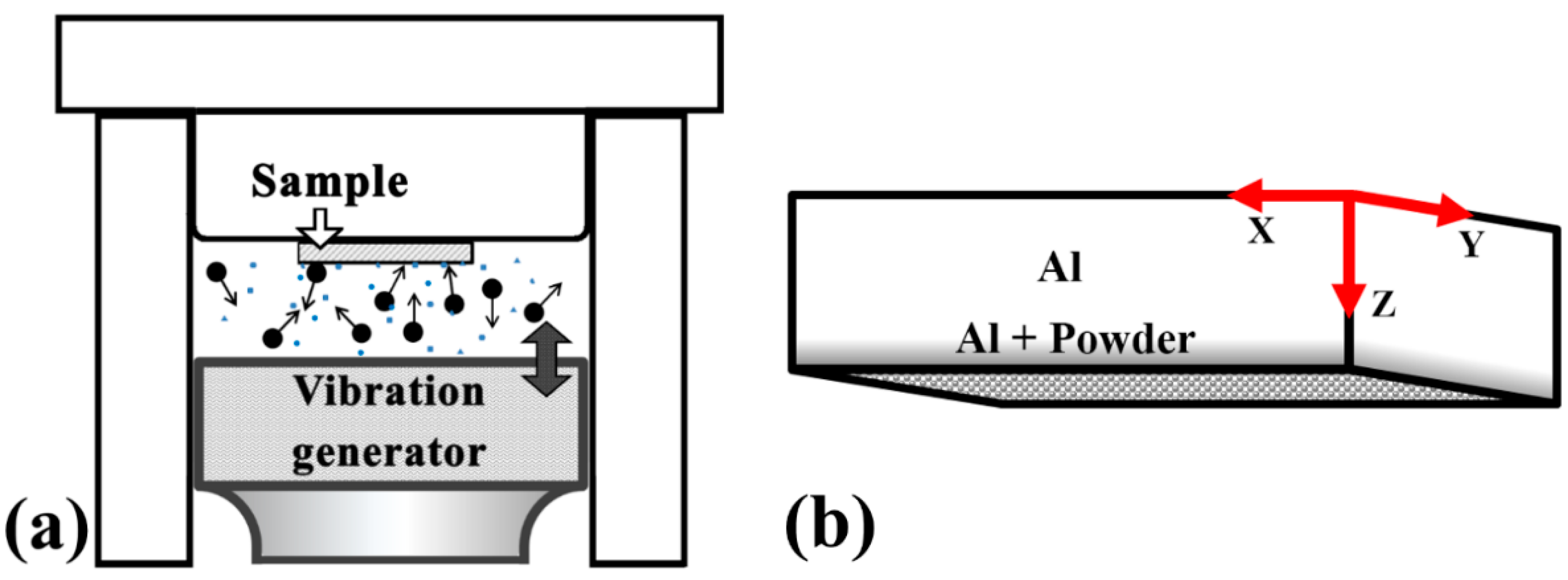
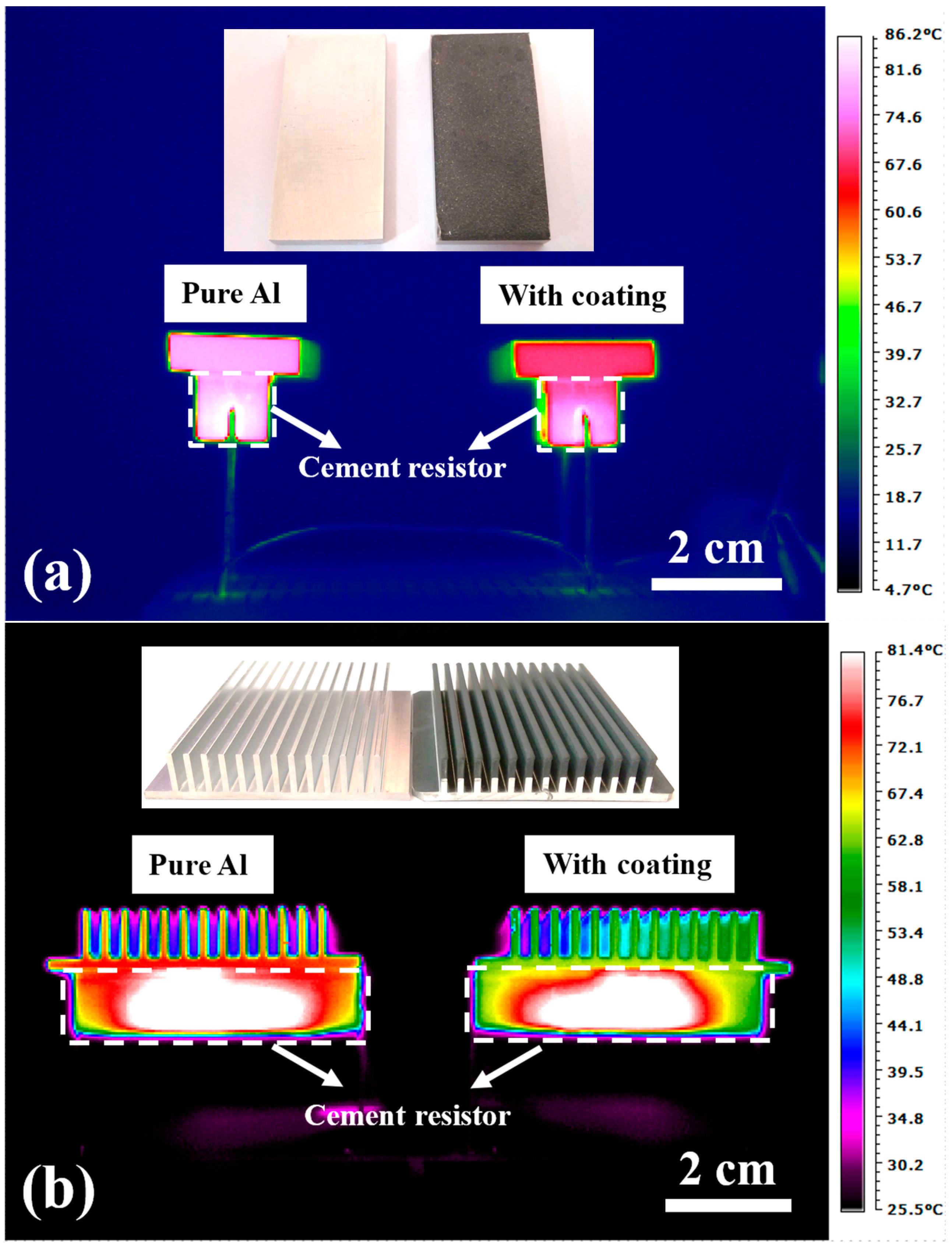

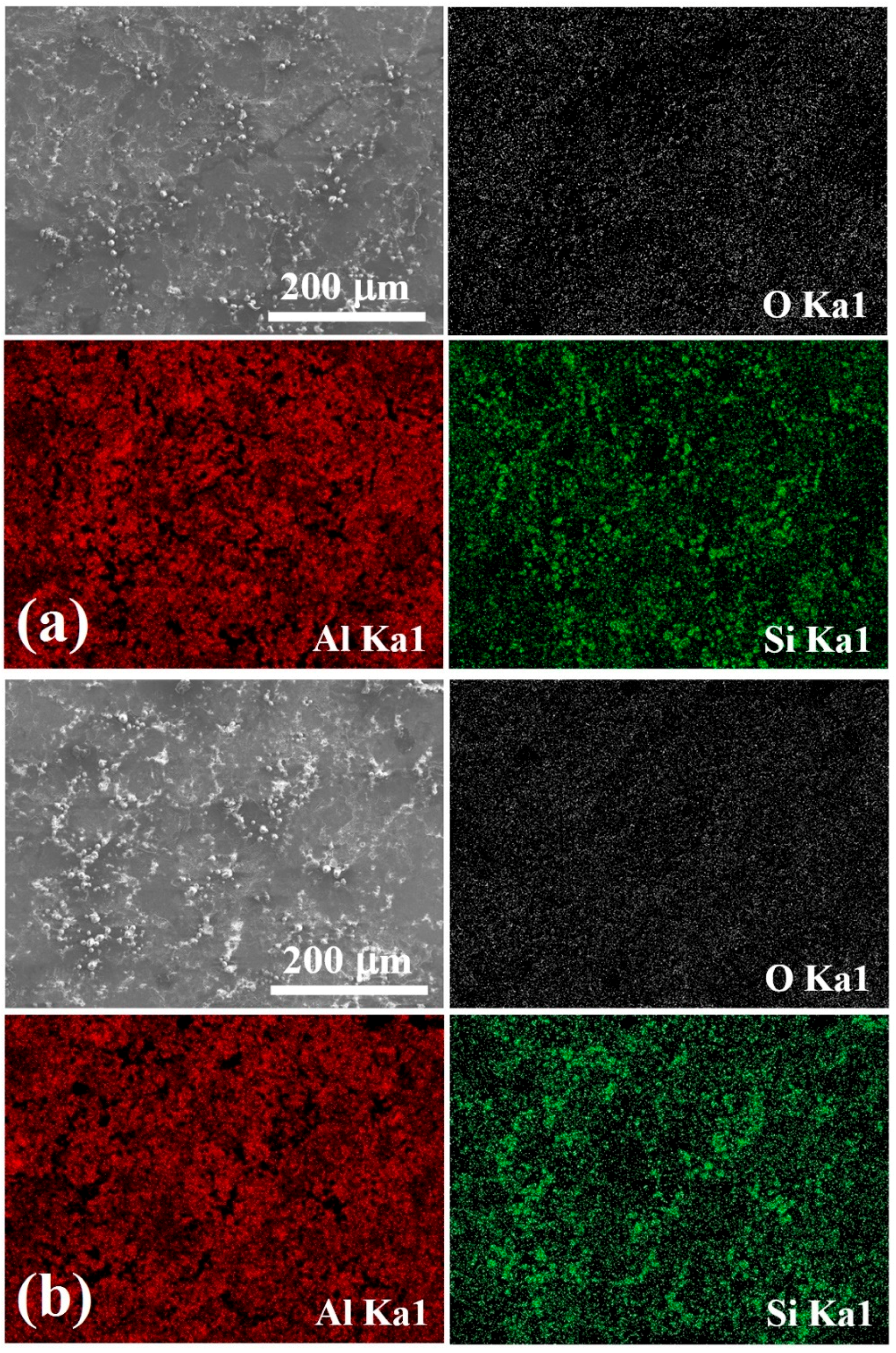
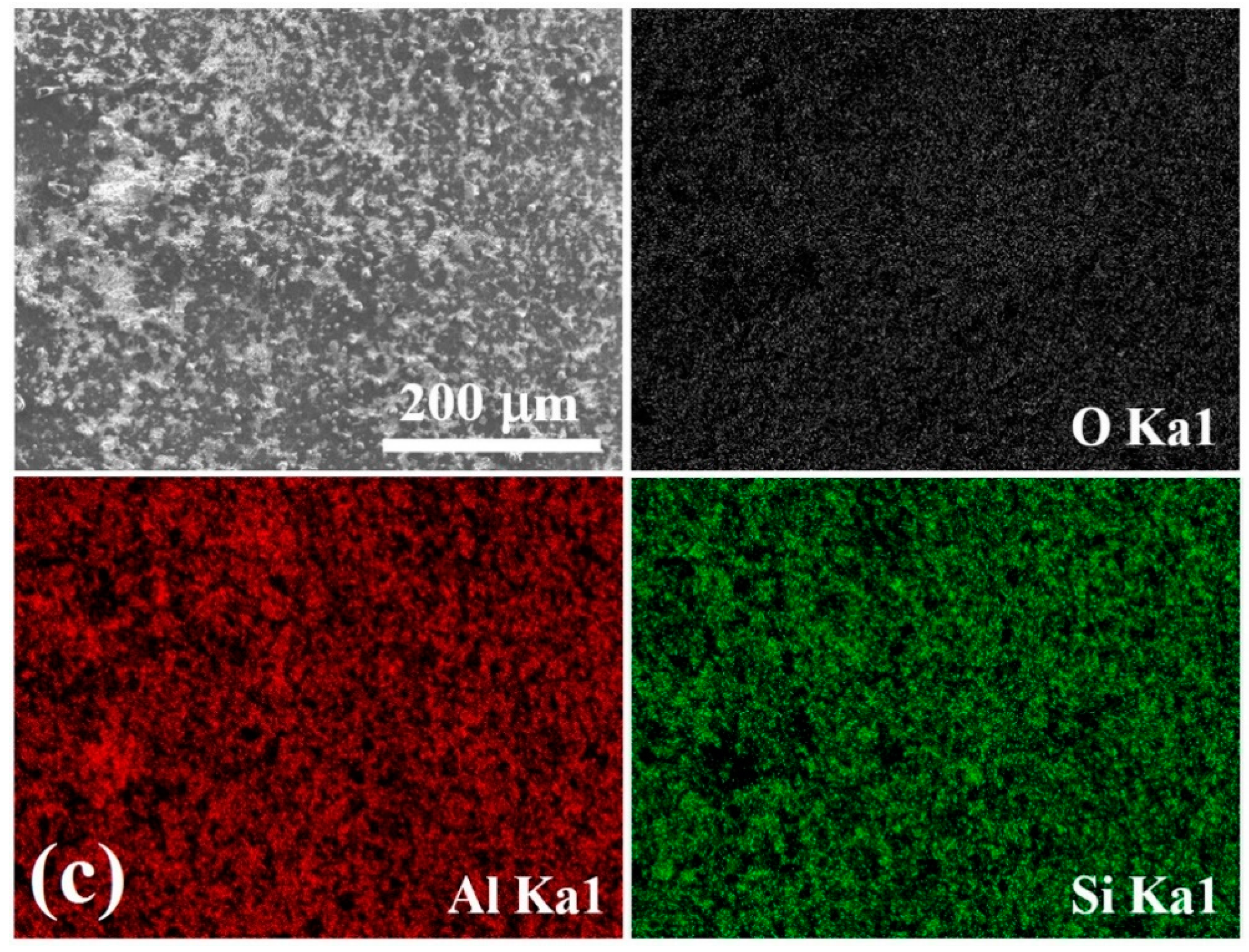
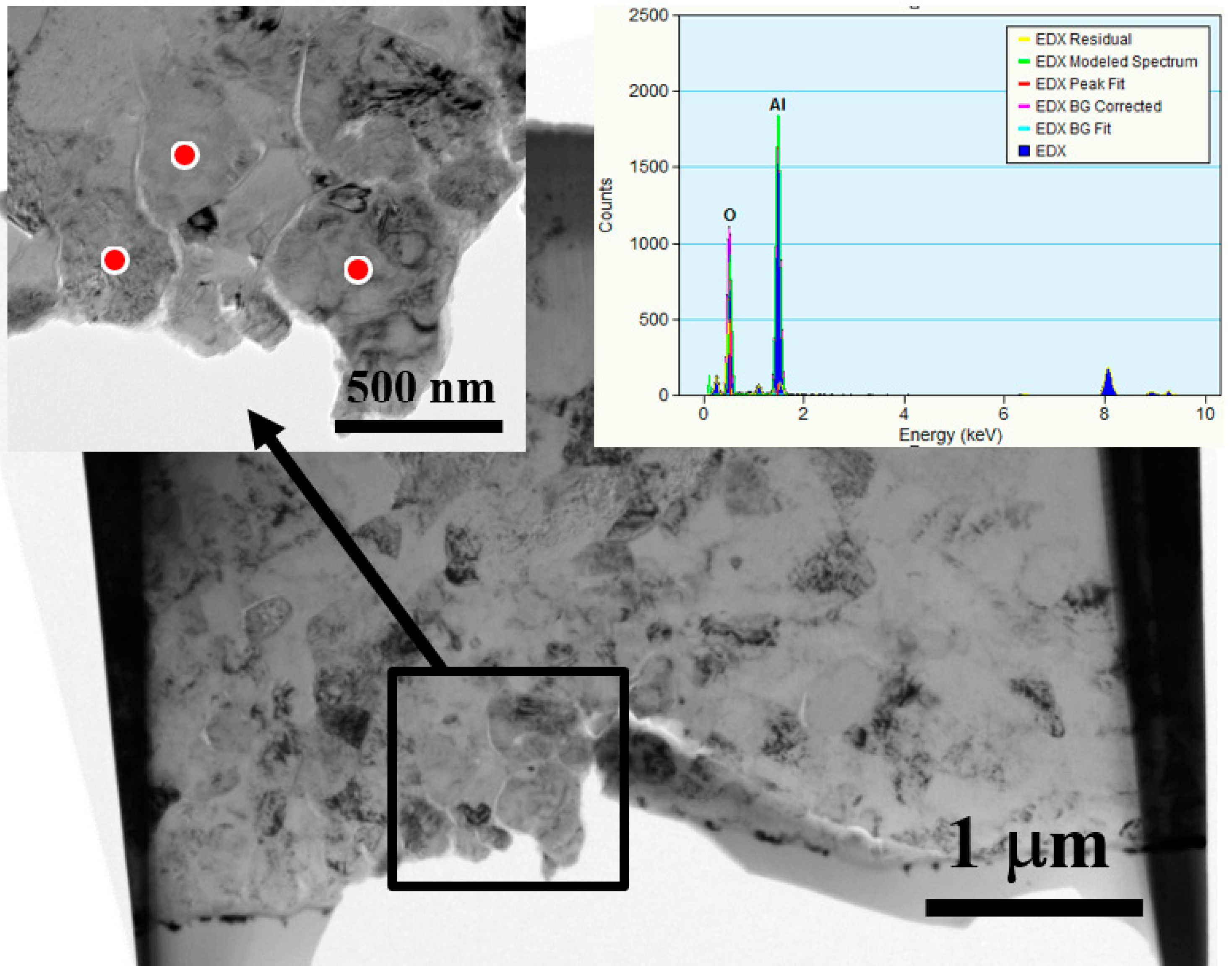
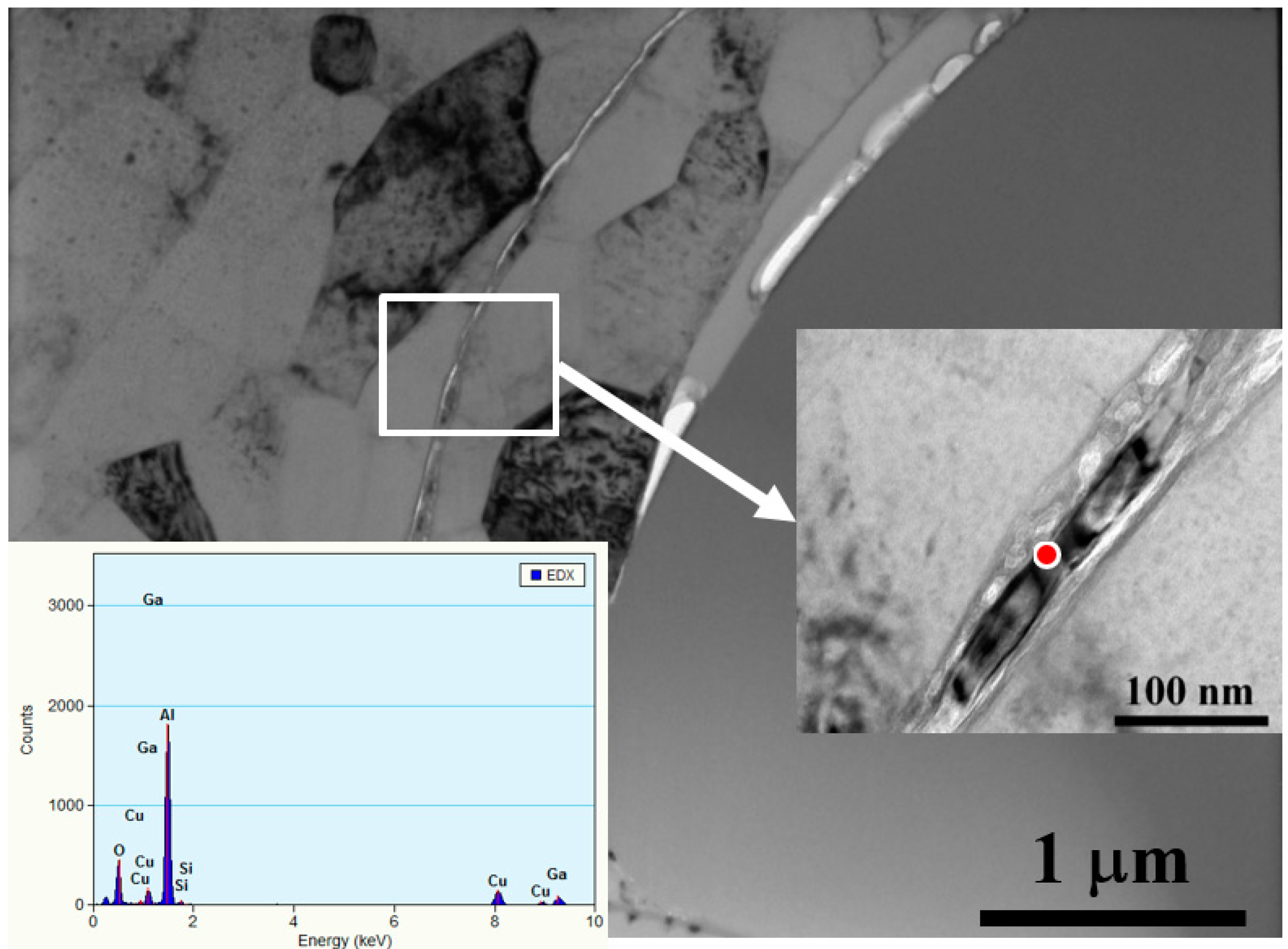
| Powder | SiO2 | Al2O3 (1) | Al2O3 (2) | Graphite |
|---|---|---|---|---|
| Diameter (μm) | ~15 | ~0.5 | ~15 | ~15 |
| Normal total emissivity, | 0.9 | 0.94 | 0.94 | 0.98 |
| Thermal conductivity, k (W/mK) | 1.3–1.5 | 12–38 | 12–38 | 25–470 |
| Convection Coefficient | ||||
|---|---|---|---|---|
| Value | 2.37 W/m2K | 2.92 W/m2K1.25 | 3.21 W/m2K | 3.43 W/m2K1.25 |
| Al2O3 Size (μm) | UMCA Cycle | (W) | T (°C) | T’ (°C) | ΔT (°C) | |||
|---|---|---|---|---|---|---|---|---|
| Ta | Te | Ta’ | Te’ | ΔTa | ΔTe | |||
| 0.5 | 3 | 2.4 | 83.9 | 83.5 ± 0.3 | 80.4 | 79.9 ± 0.4 | 3.5 | 3.6 ± 0.3 |
| 15 | 3 | 2.4 | 83.9 | 83.5 ± 0.3 | 78.3 | 78.2 ± 0.2 | 5.6 | 5.3 ± 0.2 |
| Al2O3 Size (μm) | UMCA Cycle | (W) | T (°C) | T’ (°C) | ΔT (°C) | |||
|---|---|---|---|---|---|---|---|---|
| Ta | Te | Ta’ | Te’ | ΔTa | ΔTe | |||
| 15 | 1 | 2.4 | 83.9 | 83.5 ± 0.3 | 79.7 | 79.8 ± 0.2 | 3.2 | 3.7 ± 0.2 |
| 15 | 2 | 2.4 | 83.9 | 83.5 ± 0.3 | 78.7 | 78.7 ± 0.3 | 5.2 | 4.8 ± 0.3 |
| 15 | 3 | 2.4 | 83.9 | 83.5 ± 0.3 | 78.3 | 78.2 ± 0.2 | 5.6 | 5.3 ± 0.2 |
| SiO2 Size (μm) | UMCA Cycle | (W) | T (°C) | T’ (°C) | ΔT (°C) | |||
|---|---|---|---|---|---|---|---|---|
| Ta | Te | Ta’ | Te’ | ΔTa | ΔTe | |||
| 15 | 1 | 2.4 | 83.9 | 83.5 ± 0.3 | 80.5 | 80.3 ± 0.2 | 3.4 | 3.2 ± 0.2 |
| 15 | 2 | 2.4 | 83.9 | 83.5 ± 0.3 | 78.7 | 78.9 ± 0.3 | 5.2 | 4.6 ± 0.3 |
| 15 | 3 | 2.4 | 83.9 | 83.5 ± 0.3 | 78.3 | 78.5 ± 0.2 | 5.6 | 5.0 ± 0.2 |
| Al2O3 Size (μm) | UMCA Cycle | (W) | T (°C) | T’ (°C) | ΔT (°C) | |||
|---|---|---|---|---|---|---|---|---|
| Ta | Te | Ta’ | Te’ | ΔTa | ΔTe | |||
| 15 | 3 | 1.6 | 65.7 | 66.2 ± 0.1 | 62.1 | 62.2 ± 0.1 | 3.6 | 4.0 ± 0.1 |
| 15 | 3 | 2.4 | 83.9 | 83.5 ± 0.3 | 78.3 | 78.2 ± 0.2 | 5.6 | 5.3 ± 0.2 |
| Coating | Powder Size (μm) | Cycle | (W) | T (°C) | T’ (°C) | ΔT (°C) |
|---|---|---|---|---|---|---|
| Coating on the single plate | ||||||
| SiO2 | ~15 | 3 | 2.4 | 83.5 ± 0.3 | 78.5 ± 0.2 | 5.0 ± 0.2 |
| Al2O3 | ~15 | 3 | 2.4 | 83.5 ± 0.3 | 78.2 ± 0.2 | 5.3 ± 0.2 |
| Graphite | ~15 | 3 | 2.4 | 83.5 ± 0.3 | 77.2 ± 0.3 | 6.3 ± 0.3 |
| SiO2+Al2O3 | ~15 | 3 | 2.4 | 83.5 ± 0.3 | 78.9 ± 0.1 | 4.6 ± 0.2 |
| SiO2+Al2O3 | ~15 | 10 | 2.4 | 83.5 ± 0.3 | 76.9 ±0.3 | 6.6 ± 0.3 |
| SiO2+Al2O3+Graphite | ~15 | 3 | 2.4 | 83.5 ± 0.3 | 75.8 ± 0.3 | 7.7 ± 0.3 |
| SiO2+Al2O3+Graphite | ~15 | 10 | 2.4 | 83.5 ± 0.3 | 75.3 ± 0.1 | 8.2 ± 0.2 |
| Coating on a fin | ||||||
| Al2O3+SiO2 | ~15 | 3 | 6.0 | 88.7 ± 0.2 | 80.3 ± 0.2 | 8.4 ± 0.2 |
| Al2O3+SiO2+Graphite | ~15 | 3 | 6.0 | 88.7 ± 0.2 | 77.6 ± 0.3 | 11.1 ± 0.3 |
© 2017 by the authors. Licensee MDPI, Basel, Switzerland. This article is an open access article distributed under the terms and conditions of the Creative Commons Attribution (CC BY) license (http://creativecommons.org/licenses/by/4.0/).
Share and Cite
Tsai, W.-Y.; Huang, G.-R.; Wang, K.-K.; Chen, C.-F.; Huang, J.C. High Thermal Dissipation of Al Heat Sink When Inserting Ceramic Powders by Ultrasonic Mechanical Coating and Armoring. Materials 2017, 10, 454. https://doi.org/10.3390/ma10050454
Tsai W-Y, Huang G-R, Wang K-K, Chen C-F, Huang JC. High Thermal Dissipation of Al Heat Sink When Inserting Ceramic Powders by Ultrasonic Mechanical Coating and Armoring. Materials. 2017; 10(5):454. https://doi.org/10.3390/ma10050454
Chicago/Turabian StyleTsai, Wei-Yu, Guan-Rong Huang, Kuang-Kuo Wang, Chin-Fu Chen, and J. C. Huang. 2017. "High Thermal Dissipation of Al Heat Sink When Inserting Ceramic Powders by Ultrasonic Mechanical Coating and Armoring" Materials 10, no. 5: 454. https://doi.org/10.3390/ma10050454





